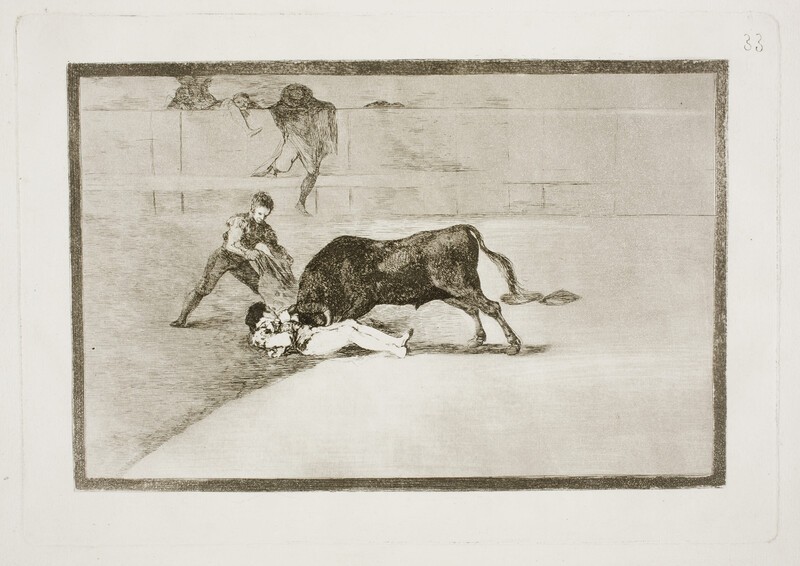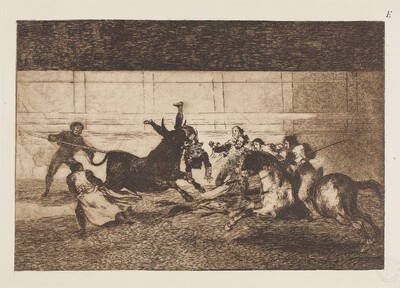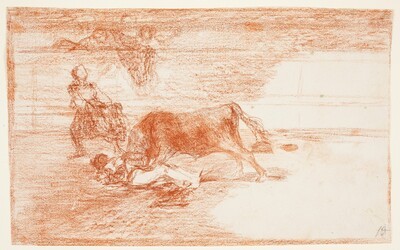- Cronología
- 1814 - 1816
- Dimensiones
- 245 x 353 mm
- Técnica y soporte
- Aguafuerte, aguatinta, punta seca, buril y bruñidor
- Reconocimiento de la autoría de Goya
- Documented work
- Ficha: realización/revisión
- 02 Oct 2021 / 22 Jun 2023
- Inventario
- -
- Otros títulos:
-
33 (print, upper right-hand corner)
See How the ancient Spaniards hunted bulls on horseback in the countryside
Two state proofs of this print have been preserved: the first before applying the aquatint and the second before applying the additional aquatint on the perimeter frame.
The plate is kept at the National Chalcography (no. 366).
See How the ancient Spaniards hunted bulls on horseback in the countryside
With this print Goya decided to bring to a close the Bullfighting series, which officially ended here during the artist's lifetime. It depicts the death of the famous bullfighter Pepe Illo (1754-1801), one of the most prominent bullfighters of the last quarter of the 18th century and the main rival of Pedro Romero (1754-1839), the bullfighter most admired by the artist. This death, which occurred on 11 May 1801 in the Madrid bullring, was very traumatic and went down in the history of bullfighting both for the importance of the bullfighter and for the fact that it was witnessed by many people and narrated by various writers, including Queen María Luisa, who witnessed the tragedy and recorded it in a letter. It is not known whether Goya attended the bullfight that day, but given the large number of surviving accounts of the tragic event, it must not have been difficult for him to depict it faithfully
In the picture we see the bullfighter lyingon the sand after having been previously wounded in the leg by the bull, which is on top of him, stabbing him in the stomach with one of its horns. At the same time, a member of his crew, using his cape, tries to pull the bull away from the bull in an attempt to save the master. In the background we see the barrier of the bullring and how two men are jumping into the ring to help in the situation. The shadow cast by the stands on the bullring helps to give an idea of where the action is taking place, as otherwise the space would not appear to be circular. Half of the scene is in shadow and the other half is illuminated.
On 11 May 1801, Pepe Illo (Pepe-Hillo), who had been bullfighting all day and who had suffered a minor mishap in the morning, continued to fight after lunch until this bull, the seventh of the afternoon, stuck his leg with a piton and threw him to the sand, where he fell face up and unconscious. Once he was there, the bull stuck one of his horns again, more viciously, in his stomach, a mortal wound from which he died in the infirmary twenty minutes later.
Goya engraved two other scenes capturing different moments of the bullfighter's fatal goring, which he eventually discarded and did not include in the official edition of Tauromaquia, although they were finally published in the enlarged edition that Loizelet produced in 1876: The Death of Pepe Illo (Bullfight E) and The Death of Pepe Illo (Bullfight F). In this connection, Sayre believes that Goya rejected plates E and F for the final composition, finally publishing only the present print, which is undoubtedly the simplest and most desolate of the three.
The almost dead body of the bullfighter in the present print inspired Manet in his famous etching Le torero mort (1864-1868).
It is also worth noting that Goya dedicated another print in Bullfighting to Pepe Illo, very different from the previous ones, as it focuses on his great skills as a bullfighter although it also alludes to his tendency towards recklessness: Pepe Illo trimming the bull.
There is a preparatory drawing of this engraving, also titled The unfortunate death of Pepe Illo in Madrid's bullring
-
Grabados y dibujos de Goya en la Biblioteca NacionalBiblioteca NacionalMadrid1946catalogue Elena Páez Ríos
-
Goya en la Biblioteca Nacional. Exposición de grabados y dibujos en el sesquicentenario de su muerteBiblioteca NacionalMadrid1978May - June 1978
-
Grabados de Goya: colección propiedad de la Biblioteca Nacional, que se conserva en su Gabinete deCasa de la Amistad de MoscúMoscow1979exhibition displayed from January 18th to 31st 1979
-
Goya. Das Zeitalter der Revolucionen. Kunst um 1800 (1980 – 1981)Hamburger KunsthalleHamburg1980cat. 260
-
1984
-
Madrid1987
-
Goya: toros y torerosEspace Van GoghArles1990displayed also at Academia de Bellas Artes de San Fernando, Madrid, consultant editor Pierre Gassier.cat. 49
-
Goya grabadorFundación Juan MarchMadrid1994consultant editors Alfonso E. Pérez Sánchez and Julián Gállego, from January 14th to March 20th 1994
-
Goya grabadorMuseo del Grabado Español ContemporáneoMarbella1996from March 8th to May 5th 1996
-
Zaragoza1996
-
Ydioma universal: Goya en la Biblioteca NacionalBiblioteca NacionalMadrid1996from September 19th to December 15th 1996cat. 274
-
Schlaf der Vernunft. Original radierungen von Francisco de GoyaMunich2000
-
Madrid2002
-
Madrid2002
-
Bilbao2012
-
Goya et la modernitéPinacothèque de ParisParís2013from October 11st 2013 to March 16th 2014cat. 38
-
Zaragoza2017
-
1946pp. 177-216, espec. pp. 207-210
-
BarcelonaTartessos-F. Oliver Branchfelt1946 (reed. 1951)
-
1961pp. 120-127
-
OxfordBruno Cassirer1964vol. II, 1964, p. 349-350, cat. 236
-
Vie et ouvre de Francisco de GoyaParísOffice du livre1970p. 280, cat. 1217
-
The Changing image: Prints by Francisco GoyaBostonMuseum of Fine Arts1974pp. 244-247, cat. 196-199
-
Goya, Das Zeitalter de Revolutionen. 1789-1830HamburgPrestel-Verlag Münche und Hamburger Kunsthalle1980p. 295
-
MilwakeeMilwaukee Art Museum1986pp. 16, 19, 26-27 y 32
-
Goya, toros y torerosMadridMinisterio de Cultura, Comunidad de Madrid1990p. 116
-
MadridCaser-Turner1992pp. 23 y 37
-
Catálogo de las estampas de Goya en la Biblioteca NacionalMadridMinisterio de Educación y Cultura, Biblioteca Nacional1996cat. 358
-
Ydioma universal: Goya en la Biblioteca NacionalMadridBiblioteca Nacional, Sociedad Estatal Goya 96 y Lunwerg1996p. 247
-
MadridMuseo Nacional del Prado2001pp. 97-99
-
ParísPinacoteca de París2013p. 110
-
Goya. In the Norton Simon MuseumPasadenaNorton Simon Museum2016pp. 186-201




